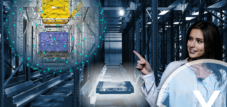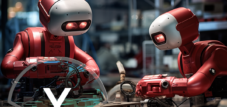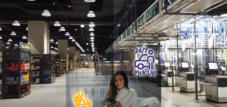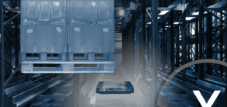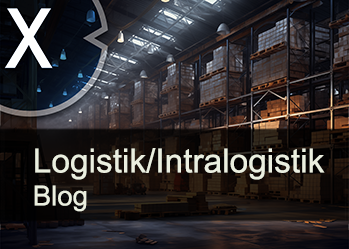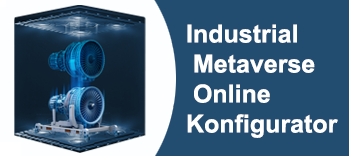Shuttle vs. robot | Shuttle systems vs. Autonomous robot: A comprehensive analysis of the dominant warehouse systems of the future
Xpert pre-release
Language selection 📢
Published on: July 19, 2025 / update from: July 19, 2025 – Author: Konrad Wolfenstein
Autonomous robot or shuttle systems? Transformative warehouse technology: What strategy does companies ensure the competitive advantage?
The automation revolution in intralogistics
The intralogistics, the nervous system of modern economy, is located in the middle of a profound transformation. The question of which warehouse system will dominate the future – the structured, throughput optimized shuttle system or the flexible, autonomous robot – is much more than a technical discussion. It has become a central strategic course that decides on the competitiveness, resilience and future viability of companies in an increasingly volatile world.
Suitable for:
- Top Ten Vertical & Horizontal AGVs (Automated Guided Vehicles) & Robot Shuttle Systems from Manufacturers and Companies | Metaverse Marketing
Why is the debate “Shuttle vs. Robot” so crucial for the future of industry today?
Three fundamental forces drive this development unstoppable.
- First, the exponential growth of e-commerce has redefined the expectations of customers forever. The demand for immediate availability, the same day delivery and error-free order processing creates an immense pressure on the warehouse and distribution centers.
- Second, a persistent shortage of skilled and labor in many industrialized nations dramatically tightens the situation. Finding and keeping qualified staff for repetitive and physically exhausting camp activities becomes one of the greatest operational hurdles.
- Thirdly, increasing operating, energy and real estate costs force to use their space more efficiently and to optimize processes down to the last detail.
Against this background, automation is no longer an option, but a necessity. The global market for warehouse automation reflects this urgency: with an estimate of $ 26.5 billion in 2024 and a forecast annual growth rate (CAGR) of over 15.9 % by 2034, it is one of the most dynamic technology. However, it is noteworthy that despite this rapid growth, around 80 % of all camps are still largely operated manually worldwide. This immense unused potential forms the battlefield on which shuttle systems and autonomous mobile robots (AMR) struggle for supremacy.
The choice between these two technological philosophies is a decision on the strategic direction of a company. It reflects a fundamental tension in modern supply chains: the conflict between the need for cost efficiency through highly optimized, predictable processes and the demand for agility through maximum adaptable, flexible processes. Shuttle systems are the physical embodiment of structured efficiency, designed for maximum storage density and highest throughput within a fixed infrastructure. AMRS, on the other hand, embody adaptive flexibility, created to navigate in dynamic, constantly changing environments. A company that invests in a shuttle system bets on a future in which its product mix and its order structure are stable enough to benefit from this extreme optimization. A company that relies on AMRS anticipates a future full of variability and unpredictability, in which the ability to quickly adapt is the decisive competitive advantage. The technological decision thus becomes a reflection of a company's strategic forecast for its own market.
Definition and functionality of nuclear technologies
What exactly is a shuttle system and what is the core components of?
A shuttle system is a highly dynamic, computer-controlled automatic small division warehouse (AKL), which is designed for the quick and efficient storage, converting and outsourcing of standardized loading units such as containers, boxes or tablets. It is a complex mechatronic system that goes far beyond the simplified analogy of a “conveyor belt”. The performance and efficiency of such a system results from the precise interaction of its core components:
- Shelf system (racks): The static backbone of the system is a highly compressed steel structure that forms bearing channels for the loading units. These shelves are designed to take advantage of the room height and can reach heights of over 20 meters, in some cases even up to 30 meters.
- Shuttles (vehicles): These are the actual “work animals”. These are autonomous vehicles that move horizontally within a shelf level on rails. Equipped with telescopic forks or similar load recordings, grab the loading units from the shelf subjects and transport them to the end of the street.
- Lifts/lifter: These essential components represent the vertical connection. They either transport the charging units or in some system architectures the shuttles themselves between the different shelves and the pre -zone, which mostly consists of conveyor technology. Your performance is often a critical factor for the overall throughput of the system.
- Promote technology (conveyors): A connected network of roles or belt conveyors forms the interface to the outside world. It transports the goods from the storage station to the lifts and from the lifts to the downstream processes such as picking, packing or shipping jobs.
- Control & software (WMS/WCS/MFS): The “Brain” of the entire operation. A higher -level warehouse management software (LVS/WMS) or a specialized Warehouse Control System (WCS) or material flow system (MFS) coordinates each individual movement. It manages the storage spaces, optimizes the driving strategies of the shuttles and lifts and ensures the seamless connection to the overarching IT landscape of the company, such as the Enterprise Resource Planning (ERP) system.
What basic types of shuttle systems are there and how do you differ in your architecture and application?
The technology of the shuttle systems has undergone a remarkable evolution that leads from rigid, one-dimensional architectures to highly flexible, three-dimensional systems. This development is a direct answer to the increasing requirements of the market for more flexibility and scalability.
- One-level shuttle (single-level shuttle): This is the classic architecture in which each shuttle is firmly bound to a single shelf level and alley. The throughput is determined by the number of shuttles per level and the performance of the lift. The scalability is primarily due to adding additional streets. Examples of this are the SSI Flexi or Cuby systems.
- Multi-level shuttle (multi-level shuttle): This variant, often referred to as a “hermaphrodite” between a classic shelf control unit (RBG) and a shuttle, can operate several levels within a alley via an integrated lifting mechanism. This reduces the complexity and the costs for shelf steel construction and offers an attractive price-performance ratio for the medium to high power range. One example is the Schäfer Lift & Run (SLR) system.
- Change of alleys / 3D shuttles: a significant evolutionary jump. These shuttles can not only drive horizontally in their alley, but also change the streets. As a result, the performance (number of shuttles) is completely decoupled from the storage capacity (number of shelf parking spaces). A company can start with just a few shuttles and simply add additional vehicles with increasing demand. In addition, they enable the creation of a 100 percent sequence of the goods to be outsourced directly in the system, which can make downstream sorting processes superfluous. The Knight Evo Shuttle 2D is a prominent representative of this genre.
- Climbing robot / cube-storage systems: This revolutionary further development blows up the traditional shuttle architecture. Here, robots either drive up and down on the shelf structure on a grid frame above densely stacked containers (e.g. autostore) or climbing (e.g. Exotec Skypod). These 3D systems completely eliminate the need for separate gears and lifts, which leads to extremely high storage density and flexibility.
- Palette shuttles: A specialized category for the high-density storage of entire pallets. These robust shuttles operate in deep warehouse channels and are often used in cold stores or for buffer stores in production.
This technological evolution within the shuttle world is remarkable. It shows that the manufacturers have recognized the challenge of the more flexible AMRs and actively try to integrate amr-like properties – such as the ability to change alleys or act three-dimensional – into their paradigm of high-density storage. As a result, the once clear boundaries blur, and the most advanced “shuttle systems” are basically specialized, vertically oriented AMR systems that operate in a defined structure.
What is a “robot” in the storage context and what is the decisive difference between autonomous mobile robots (AMR) and driverless transport systems (FTS/AGV)?
In the storage context, the distinction between “robot” as a general term and the specific technologies FTS (driverless transport system, English AGV for automated guided vehicles) and AMR (autonomous mobile robot) is of fundamental importance. Although both materials transport, they are based on fundamentally different navigation philosophies.
- FTS / AGV (driverless transport system / Automated Guided Vehicle): This is the older, established technology. FTS are “guided” vehicles. They follow solid, physically or virtually defined paths, which are determined by magnetic strips in the soil, colored lines, laser scanners that are aimed at reflectors or other control systems. Your intelligence is limited: if an FTS meets an obstacle, stops it and waits for the path to be clear again. The implementation is complex, often requires structural adjustments to the infrastructure and the resulting system is rigid. Any change in the route is associated with considerable effort.
- AMR (autonomous mobile robot / autonomous mobile robot): This is the newer, far more intelligent and more flexible technology. Amrs are “autonomous” vehicles. You don't need an external tour. Instead, create a digital map of your surroundings and navigate freely, similar to a self -driving car. With the help of their advanced sensors, they recognize obstacles such as people, forklifts or parked pallets in real time and dynamically plan an alternative route to avoid them. Your implementation is fast, does not require structural changes and offers the highest level of flexibility.
While the technological boundaries are increasingly blurred, since FTS are also equipped with more intelligent functions, the core difference remains: an FTS follows a predefined track, an AMR navigates intelligently in a freely navigable space. For the following analysis, the focus is therefore clearly on the flexible AMRs as the actual technological opposite pole to the structured shuttle systems.
How do AMRS navigate and act in a dynamic warehouse environment to autonomously perform your tasks?
The autonomy and flexibility of AMRS are based on a highly developed interplay of mapping, sensors and intelligent software. The process can be divided into several steps:
- Mapping (mapping): Before an AMR can start its work, a digital map of the warehouse must be created. This happens either “offline” by driving a robot manually through the environment to collect the data or “online”, whereby the robot creates and refines the card in real time during operation.
- Localization (slam): To know where it is, the AMR uses a technology called Slam (Simultaneous Localization and Mapping). The robot continuously compares the data of its sensors with the stored card in order to determine its own position and alignment in real time with high precision.
- Sensorism: AMRs are equipped with a variety of sensors that provide you with a comprehensive 360-degree laying picture of your surroundings:
- Lidar (Light Detection and Ranging): Send laser scanner out of light impulses and measure their reflections to create a precise point cloud in the area. This is the primary technology for mapping and detection of obstacles in the distance.
- 3D cameras: capture visual data and depth information, which improves the detection of objects. They are often used for fine positioning by reading QR codes or other markings on the ground or on shelves.
- IMU (Inertial Measurement Unit): an inertia measuring system that measures acceleration and rotating rates and helps the robot to pursue its own movement between the sensor updates.
- Navigation and avoidance of obstacles: The fleet management system gives the AMR a goal (e.g. “driving to Packstation 5”). The robot then calculates the optimal route. The sensors permanently monitor the way while driving. If an unexpected obstacle is recognized, the AMR does not easily stop, but analyze the situation and plans a bypass route in a fractions of a second to achieve its goal.
- Artificial intelligence (AI) and machine learning (ML): In the background, advanced algorithms work that interpret the huge amounts of data of the sensors, make the safest and most efficient decisions on route planning and improve the navigation performance of the robot through continuous learning over time.
Shuttle vs. AMR: Intelligent robot or classic shuttle systems?
Direct system comparison – a multidimensional analysis
How do shuttle systems and AMRs do in direct performance comparison regarding throughput and speed?
The performance, measured by throughput (e.g. input and outsourcing per hour), is one of the central distinguishing features between the two system philosophies.
Shuttle systems are designed from scratch for extremely high throughput in a defined environment. Your architecture is designed to parallel movements. While dozens of shuttles move horizontally on their respective levels at the same time, the lifts work vertically regardless of it. This decoupling of horizontal and vertical transport routes enables massive performance peaks. Leading systems can achieve throughput rates of over 1,000 double games (one and outsourcing) per hour and alley. This makes shuttle systems the undisputed “sprinter” for high-frequency, repetitive input and outsourcing tasks in a fixed structure.
Autonomous mobile robots (AMR), on the other hand, are not primarily optimized in the smallest space for maximum throughput. Their strength lies in the flexible and efficient transport of goods via variable and often long distances in a dynamic environment. A single AMR can reach speeds of up to 4 m/s, but the overall throughput of a fleet depends on many factors: the complexity of the roads, the volume of traffic by other robots or humans, the distance between the stations and the general order structure. They are more of the “marathon runners” who adapt to changing conditions.
However, the convergence of the technologies already mentioned can also be seen here. So-called Cube storage systems such as the Exotec Skypod based on climbing robots are explicitly designed to combine the flexibility of AMRS with a very high throughput. At connected picking stations, services of up to 400 picks per hour and station can be achieved. These hybrid approaches are increasingly questioning the traditional dichotomy of “Shuttle = high throughput” and “amr = high flexibility”.
Suitable for:
- Strengthen people through automation: the development of human-robot collaboration in modern storage
Which system offers a higher storage density and uses the available space more efficiently?
The storage density is a traditional core argument and a domain of the shuttle systems. In a world of increasing real estate and property prices, the maximum use of volume is a crucial economic factor.
Shuttle systems offer an unsurpassed storage density. The storage space is extremely compacted by minimizing the number of operating and the ability to take advantage of the total available building height of up to 30 meters and more. Techniques such as double or multiple depth storage of containers within the channels maximize the capacity on a given floor area.
AMRS in its classic form, which transport the goods between well -distributed shelves, naturally need wider roads and cannot use the vertical dimension so efficiently. Their optimization is not aimed at the static storage density, but on the dynamic process efficiency.
But the clear limits also dissolve in this discipline. The already mentioned Cube Storage systems (such as Autostore or Exotec Skypod) achieve an extremely high storage density by stacking containers directly without shelves and accessing the robots from above to the required container. They combine the density of a compact camp with the flexibility of robots. Another development are climbing AMRS (automated climbing robots, ACRS) that are able to operate high standard shelf and thus significantly improve vertical use of space compared to pure floor vehicles.
How flexible and scalable are the two systems with regard to changing business requirements and seasonal tips?
Flexibility and scalability are the parade disciplines of the AMRs and often represent the decisive argument for their use in volatile markets.
Amrs offer the highest level of flexibility and scalability:
- Scalability: Adaptation to a higher order volume is very easy. In order to increase throughput, other robots are simply added to the existing fleet. This process can take place within minutes or hours without an interruption. The storage capacity can be expanded by setting up additional shelves completely independently of the throughput (i.e. the number of robots).
- Flexibility: AMRS are software -defined. New roads, additional work stations or completely changed process drains can be implemented immediately via software update. The system adapts to a new warehouse layout or changed requirements without any physical conversions. This makes it the ideal solution for highly dynamic environments such as e -commerce or logistics for third -party providers (3PL), where order volumes and structures fluctuate sharply.
Shuttle systems are traditionally significantly rigid:
- Scalability: Modern shuttle systems are modular and in principle scalable, but the process is much more complex. Additional shuttles can be inserted into the alleys to increase throughput, or grow entire shelves to expand the storage capacity. However, such extensions are significant construction projects that require longer planning, high investments and often partially or complete interruption.
- Flexibility: The basic infrastructure from shelf alleys, rails and lifts is fixed. A fundamental change in the material flow, for example the laying of a picking zone to another point, is extremely difficult and expensive. The system is designed for a specific, optimized process and is difficult to adapt to fundamental changes.
How do the systems differ in terms of investment costs (Capex), operating costs (Opex) and the implementation time?
The analysis of the total costs (Total Cost of Ownership, TCO) and the implementation speed reveals fundamentally different business models and is of crucial importance for the investment decision.
- Initial investment (Capex):
- Shuttle systems: are associated with very high initial investments. The costs include not only the vehicles themselves, but a massive infrastructure of high -precision steel construction, powerful lifts, kilometers -long conveyor technology and complex control technology.
- Amrs: require significantly lower initial investments. Since they navigate in the existing infrastructure, expensive and elaborate conversions are eliminated. Companies can start with a small fleet of just a few robots and gradually adapt their investment to business growth (“pay-as-you-grow”). Models such as “Robot-As-A-Service” (RAAS) (RAAS) are also increasingly established, in which the hardware is rented, which further lowers the Capex hurdle and converts the costs into variable operating expenses (Opex).
- Implementation time:
- Shuttle systems: The implementation of a shuttle project is a lengthy process that can take many months or even years from planning to production to installation and commissioning. The installation inevitably leads to considerable operating interruptions.
- AMRS: The implementation is extremely fast. After mapping of the surroundings, the robots can often be put into operation within a few days or weeks, often even in parallel for ongoing operation. This fast use leads to a much faster return on investment (ROI), which in many cases can be below one year.
- Operating costs (Opex):
- Shuttle systems: Due to their high efficiency and reduced personnel requirements, can be very cost-effective in the company in the long term. However, maintaining the complex overall system can be demanding and expensive. However, modern shuttles are significantly more energy -efficient than older shelf control units.
- AMRS: The maintenance costs per robot are relatively low, but with a large fleet, the total effort for maintenance and battery management must be taken into account. Modern lithium-ion batteries and intelligent, automated charging cycles keep energy consumption and operational effort.
The financial models on which these technologies are based are as different as their technical properties. Shuttle systems represent a traditional, long-term major project that requires a high level of investment security and precise forecasts about future needs. AMRS, on the other hand, stand for a paradigm shift towards agile financing and operational expenses, especially with RAAS models. They allow companies to consider automation as a scalable service instead of a bound fixed assets. This financial flexibility is just as disruptive for many companies as the technology itself and democratizes access to advanced logistics automation by also enabling smaller and medium -sized companies to compete with the industry giants.
Detailed comparison of criteria: Shuttle systems vs. Autonomous mobile robot (AMR)

Detailed comparison of criteria: Shuttle systems vs. Autonomous mobile robot (AMR) – : Xpert.digital
The comparison between shuttle systems and autonomous mobile robots (AMR) shows a fascinating development in warehouse technology. Both systems have their specific strengths and weaknesses, which must be weighted differently depending on the application.
Shuttle systems shine due to an extremely high throughput of over 1,000 double games per hour and maximum use of space up to 30 meters. They are ideal for stable, repetitive processes with a high volume. However, the investment costs are considerable and the flexibility is limited by the solid infrastructure.
In contrast, autonomous mobile robots offer remarkable process flexibility. Your routes and tasks can be quickly adjusted via software, which makes it perfect for dynamic environments. The implementation time is short and the initial investments are significantly lower. Modern approaches such as cube storage systems already show how both technologies can converge.
The choice between shuttle systems and AMRS depends on specific corporate requirements: If you need high throughput and storage density, shuttle systems are optimal. If you look for flexibility and quick scalability, AMRs are the better choice. Companies are also increasingly relying on hybrid solutions to combine the advantages of both technologies.
The brain of the operation – software, control and integration
What role does the software play in the control of shuttle systems and how does integration into the existing IT landscape (LVS/WMS) take place?
Without an intelligent software layer, a shuttle system is just a collection of “stupid metal”. The actual potential is only developed by interaction with the digital brain of the system. This role is typically adopted by a combination of warehouse management software (LVS, English WMS) and a subjugated material flow system (MFS) or Warehouse Control System (toilet).
The tasks of this software are varied and crucial for performance:
- Warehouse management: The software decides in real time which storage space is the optimal for a newly incurring article. Criteria can be the access frequency (ABC analysis), the togetherness of articles for an order or the even utilization of the alleys.
- Order and sequence management: The system receives orders from the overarching ERP system and brings them into individual driving orders for the hardware. It ensures that the items are outsourced in the optimal order for the downstream process (e.g. packaging).
- Hardware control: The software is the conductor of the orchestra. It sends the specific driving orders to every single shuttle, every lift and every segment of conveyor technology and synchronizes its movements to ensure smooth and efficient material flow.
- Inventory control in real time: Since every single movement is recorded, the system offers a permanent, second -precise inventory. The inventory is 100 % transparent at all times.
Integration into the existing IT landscape is the key to success. The seamless communication between the WMS/MFS and the Enterprise Resource Planning (ERP) system of the company is essential. The order data, article master data and inventory information are exchanged via standardized interfaces (APIs) in order to guarantee a continuous flow of information from customer order to shipping.
Why is fleet management software indispensable for AMRS and which intelligent, AI-based functions does it offer?
If the WMS represents the strategic level that the “WAR” and “When” specifies when ”the logistics processes, the fleet management software is the tactical intelligence that“ who ”and“ How ”decides for an AMR fleet in real time. A single AMR is a tool; A fleet without central management would be pure chaos.
The fleet management software is indispensable and offers a number of highly intelligent functions:
- Traffic management: Similar to air traffic control, the software coordinates the routes of all robots in the warehouse. It prevents collisions, regulates the right of way to intersections and prevents traffic jams by dynamically controlling the flow of traffic.
- Intelligent order assignment (Task Allocation): If a new transport order receives from the WMS, the fleet management software decides, which is best suited for this task. AI-based algorithms take into account a variety of factors in real time: the current position of the robots, their battery charging, their current utilization and the priority of the order.
- AI-based route planning: The software does not just calculate the shortest way, but the most efficient. It can predict and bypass stowers, find alternative routes in blocked paths and optimize the entire material flow of the fleet in order to minimize the transport times.
- Integration of peripheral devices: Modern fleet managers not only control the robots themselves, but also orchestras their interaction with the environment. You can automatically open goals, call lifts or coordinate the handover of goods to robotic arms and conveyor belts.
- Automatic energy management: The software monitors the charge status of each robot and sends it independently and in time for the next free charging station to ensure a 24/7 operation.
A decisive progress is the development of manufacturer -independent communication standards such as VDA 5050. Fleet managers who support this standard can control heterogeneous fleet from vehicles from different manufacturers. This gives companies freedom to select the best robot for every task and prevents long-term dependence on a single provider (“Vendor-Lock-in”).
What are the biggest challenges in interoperability and seamless integration of these complex systems in existing operating processes?
The implementation of advanced automation solutions is a complex undertaking that goes far beyond pure technology. The challenges can be divided into technical and organizational aspects.
- Technical challenges:
- System compatibility and interfaces: The largest technical hurdle is to ensure smooth communication between the different software levels: ERP, WMS, MFS and fleet managers. This often requires the use of special “middleware” or the elaborate development of tailor -made programming interfaces (APIs) to let the systems “talk” to each other.
- Data harmonization: Data formats and protocols must be “translated” correctly between the systems and standardized (data mapping) so that an order from the ERP system ultimately leads to a correct physical movement in the warehouse.
- Network infrastructure: AMRS in particular rely on an extremely stable, comprehensive and powerful WLAN connection. In many existing warehouses, the network is not designed for these requirements and must be extensively upgraded.
- Security: Integration must ensure both the physical and digital security. This includes the connection to existing security systems such as emergency offices and fire protection systems as well as the protection of the entire network against cyber attacks that could paralyze a whole fleet.
- Organizational challenges:
- Employee acceptance and change management: The introduction of robots can trigger fears before losing the job at the workforce. A successful project therefore requires an open communication strategy, the early involvement of employees and comprehensive training programs to build new skills for working with the machines (e.g. fleet monitoring, maintenance).
- Process reengineering: The biggest return is not achieved by simply replacing a person with a machine. The real success lies in the basic redesign of the entire process chain in order to fully exploit the unique automation skills. This requires a rethink in the work processes, performance metrics and management philosophies.
- Initial investment: Despite the advantages, the costs, especially for comprehensive shuttle systems, represent a significant hurdle for many medium-sized companies. Strategies such as starting with small pilot projects, gradual scaling or using RAAS financing models can help to overcome this barrier.
Experience shows that the greatest challenges are often not technical but organizational in nature. An automation project is not a pure IT project, but a profound business transformation project. Companies that only try to “put” new technology into old, manual processes will not exhaust the potential. The winners will be those who use the technology as a catalyst to reinvent their entire operating model.
🎯🎯🎯 Benefit from Xpert.Digital's extensive, fivefold expertise in a comprehensive service package | R&D, XR, PR & SEM

AI & XR-3D-Rendering Machine: five times expertise from Xpert.digital in a comprehensive service package, R&D XR, Pr & SEM – Image: Xpert.digital
Xpert.Digital has in-depth knowledge of various industries. This allows us to develop tailor-made strategies that are tailored precisely to the requirements and challenges of your specific market segment. By continually analyzing market trends and following industry developments, we can act with foresight and offer innovative solutions. Through the combination of experience and knowledge, we generate added value and give our customers a decisive competitive advantage.
More about it here:
Shuttles vs. AMRS – hybrid systems: The key to the logistics success of the next decade?
Market, actors and future trends
What does the current market landscape look like and what growth forecasts are there for warehouse automation?
The market for warehouse automation is experiencing explosive growth, driven by the irreversible trends of e-commerce, omnichannel trade and global shortage of labor. The data draws a clear picture of an industry:
- Market size and growth: The global market was estimated in 2024 for a volume of $ 26.5 billion. Forecasts assume an impressive average annual growth rate (CAGR) of over 15.9 % for the period until 2034. For Europe in particular, growth of $ 4.9 billion is expected to $ 9.59 billion in 2029 in 2029, which corresponds to a CAGR of 14.4 %. Similar dynamics are shown in North America, where the US market should more than double by 2030.
- Market penetration: Despite these impressive growth figures, the potential is far from exhausted. It is estimated that only about 5 % of the warehouses worldwide are highly automated. Another 15 % use partial solutions such as conveyor belts, while the overwhelming majority of 80 % is still largely operated manually. This low degree of automation signals enormous future growth potential for technologies such as shuttle systems and AMRS.
- Regional focus: Europe, especially Germany, has one of the highest robot densities in the world and is a hotspot for OEMs and system integrators. At the same time, Central and Eastern Europe are considered to be rapidly growing future markets. In the USA, especially in the large segment of medium -sized companies, there is a considerable need to catch up on automation, which also ensures strong growth there.
Suitable for:
- Intralogistics chaos? Robot transformation in intralogistics: AI takes the tax – 3 ways to digital rescue
Which companies are the leading providers of shuttle and AMR systems?
The competitive landscape is heterogeneous. In the area of shuttle systems, large, established intralogistics providers dominate, which often offer complete total solutions from a single source. The AMR market is more dynamic and fragmented with a mixture of established industrial companies and highly specialized, agile robotics start-ups.
- Leading providers of shuttle systems (often as part of total solutions):
- Daifuku (Japan)
- SSI Schäfer (Germany)
- Dematic (part of the Kion Group, Germany)
- Knapp (Austria)
- TGW Logistics Group (Austria)
- Vanderlande (part of Toyota Industries, Netherlands)
- Mecalux (Spain)
- Swisslog (part of Kuka AG, Switzerland)
- Witron logistics + computer science (Germany)
- Leading providers of AMR systems (selection after specialization):
- Goods-to-person / climbing robot: EXOTEC (France), Geek+ (China), Hai Robotics (China).
- Person-to-goods / collaborative robot: Locus Robotics (USA), Mobile Industrial Robots (Mir, part of Teradyne, Denmark).
- Industrial AMRS & fleet management: Kuka (Germany), ABB (Switzerland/Sweden), DS Automotion (part of SSI Schäfer, Austria).
Overall, the market concentration is classified as a “medium”, which indicates a healthy and innovative competition between the actors.
Which technological trends, such as hybrid systems, AI and cobots, will shape the next generation of storage systems?
The development in warehouse automation is not silent. Several key trends will define the next generation of systems and move the limits of what is possible today.
- Hybrid systems and convergence: The strict separation between the system worlds dissolves. The future belongs to integrated, hybrid solutions that combine the respective strengths intelligently. A typical scenario is the use of a high-density shuttle or cube storage system for storage and connecting to flexible AMRs for transporting the goods to decentralized, ergonomic picking places or between different storage and production areas. This avoids rigid conveyor technology and maximizes both density and flexibility.
- Ownership artificial intelligence (AI) and machine learning (ML): AI becomes an integral part of the entire storage control from a niche function. In addition to the pure route planning for AMRS, it is used for global process optimization: Predictive analytics for predicting demand tips and for proactive adaptation of resources, intelligent inventory optimization, based on forecast orders, and adaptive learning algae, which the overall system by analyzing operating data continuously improve yourself.
- Human robot collaboration and cobots: Man will not disappear from the camp, but his role will change from manual work to surveillance, control and problem solving. Collaborative robots (cobots) and AMRS are developed to work safely and efficiently with people. Ergonomic “Goods-to-Person”-or “Goods-to-Robot” workstations, where people and machines pick hand in hand hand in hand.
- Internet of Things (IoT) and total networking: The camp of the future is completely networked. Sensors on shelves, machines, on the robots and even on the loading units themselves provide a constant stream of real-time data. This data is used by the AI systems to create a digital image of the warehouse (digital twin) and to control and optimize the physical processes with unprecedented precision.
- Sustainability and energy efficiency: In view of increasing energy costs and social pressure, sustainability becomes a decisive design criterion. Systems with low energy consumption, such as the robots of Autostore, which can supply each other with energy, or energy-efficient shuttle drives. The promotion of the circular economy through optimized return processes is also an important aspect.
Future trends in intralogistics and their effects
The future of intralogistics is shaped by several important trends that will revolutionize the performance and efficiency of logistics systems. Hybrid systems form a central strategy in which the strengths of different technologies are combined. In the future, shuttle systems will form the high-density core of an overall solution, while autonomous mobile robots (AMRS) act as a flexible link between different automated areas.
Artificial intelligence (AI) plays a key role in process optimization. It not only enables an improved warehouse strategy and predictive maintenance, but also a more complex swarm behavior of robot fleets. The human-robot collaboration develops into a decisive aspect in which robots work safely and ergonomically with human employees.
The Internet of Things (IoT) connects all warehouse components in real time and creates comprehensive transparency. Each robot becomes a mobile data hub that exchanges and analyzes information. At the same time, the sustainability aspect is becoming increasingly important. Energy-efficient drives, optimized battery technologies and AI-controlled route planning aim to minimize the ecological footprint of intralogistics.
These trends show that the future of intralogistics will be shaped by networking, intelligence and sustainability, whereby humans and technology work more and more together.
Coexistence instead of competition – which system dominates the future?
So will one system displace the other or are we moving towards a future of coexistence and hybrid solutions?
After a profound analysis of the technologies, its performance features, cost structures and future trends, it becomes clear: The question “Shuttle vs. robot” is wrong if it implies a repression of one system. The idea of a singular, all -dominating technology is a relic from a simpler time. The future of warehouse automation is not shaped by a single winner, but by an intelligent, application -specific coexistence and an increasing fusion of the technologies.
There will be no complete displacement. Instead, the systems will prevail in the areas of application in which their respective core strengths come into their own:
- Shuttle systems (and their further developments such as Cube storage) will continue to dominate where maximum storage density and extremely high, predictable throughput are the decisive criteria. This applies to buffer warehouse in industry, the supply of high-performance production lines, large central warehouse in the food retail trade or to quickly rotating articles in the e-commerce fulfillment.
- Autonomous mobile robots (AMR) will play their dominance in all areas in which flexibility, quick scalability and adaptability are in the foreground. This includes volatile e-commerce environments with strongly fluctuating order profiles, logistics for third-party providers (3PL) with frequently changing customers and requirements as well as flexible, modular production concepts.
However, the most important and most formative trend is the convergence of the technologies and the development of hybrid systems. The most powerful logistics centers of the future will not either rely on shuttles or on AMRs, but on integrated total solutions that combine the best of both worlds. The “dominance” is therefore not practiced by a certain hardware technology. The real winner in the race for the future of intralogistics is the software ecosystem. The intelligence, which is able to orchestrate heterogeneous technologies – shuttles, AMRS, cobots, conveyor technology and manual jobs – to orchestrate a highly efficient, flexible and resilient overall organism.
The future of industry is dominated by intelligent, flexible and hybrid automation ecosystems, in which the choice of the right hardware for the specific task and their perfect integration by superior software decides on success.
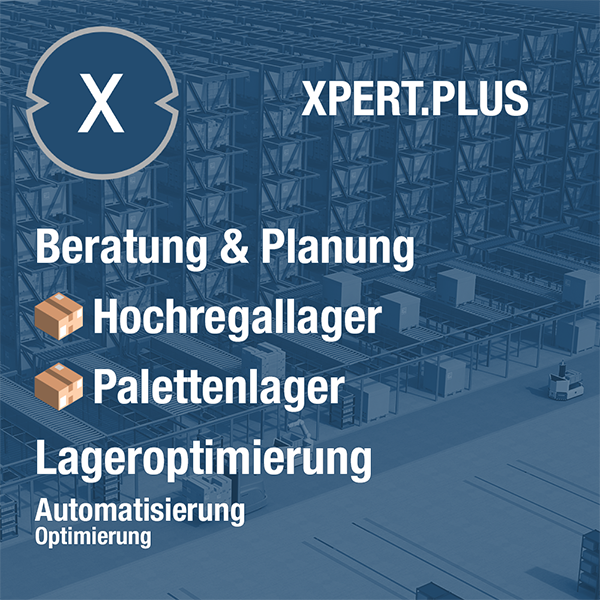
Xpert.plus warehouse optimization – high -bay warehouse such as pallet warehouse advice and planning
We are there for you – advice – planning – implementation – project management
☑️ Our business language is English or German
☑️ NEW: Correspondence in your national language!
I would be happy to serve you and my team as a personal advisor.
You can contact me by filling out the contact form or simply call me on +49 89 89 674 804 (Munich) . My email address is: wolfenstein ∂ xpert.digital
I'm looking forward to our joint project.










